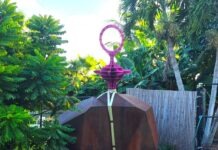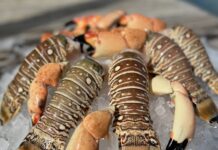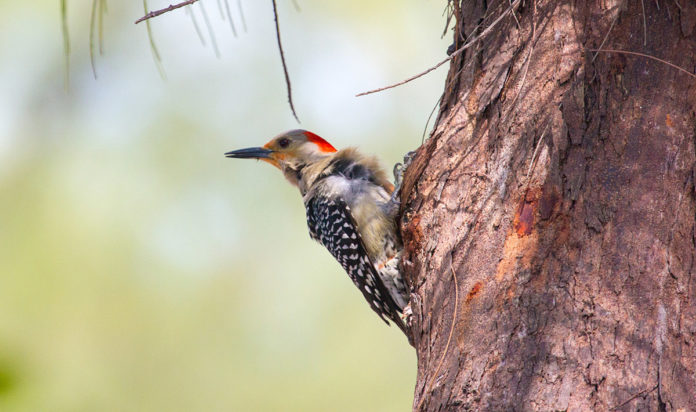What happened to the parrots that used to fly around Old Town and eat mangoes? — Banyan Tree Amy
I’m not sure when you moved here, but when I came in 1991, a small flock of parrots roamed Key West. I have a hazy memory of them landing noisily in an Emma Street tree and waking me from a pretty good nap. I wasn’t yet a bird geek, so I can’t recall with any clarity their field marks, number, species, or even if they were all the same species. I just remember a lot of green feathers and thinking, “Oh, I live in the tropics now.”
In fact, the Carolina parakeet was the only indigenous parrot ever to live in the U.S. No one is sure exactly how big their population was, but their range spread all over the East Coast and into the Plains states. Flocks of 200 to 300 were common. Habitat loss did them in, as they needed large tracts of deciduous forest to survive. Their tendency to gather around an injured or dying member of the flock also made them vulnerable to the new European settlers and their shotguns. The last Carolina parakeet died sad and alone in a cage at the Cincinnati Zoo in 1918. (Not-so-fun fact: The last carrier pigeon had died in the same cage four years earlier.)
I saw a Carolina parakeet once, but it was stuffed, and in the basement of the Smithsonian’s Natural History Museum.
So did we hallucinate these Key West parrots, Amy? Probably not. Pet parrots, imported from other regions, have a tendency to fly off and go feral, often forming flocks with other escaped parrots. They seem to thrive and contain themselves in urbanized areas, possibly because of all the imported landscaping plants. More than 50 species of exotic parrots are currently breeding in the Miami area. I’ve seen hyacinth macaws in Coral Gables and mitred parakeets in Kendall. A small flock of monk parakeets occasionally hangs out in Founders Park in Islamorada.
So what happened to that Key West flock? Odds are it never got large enough to form a breeding colony, and its members either aged out, couldn’t find the right food, caught diseases or were taken out by predators such as hawks and falcons.
What is your name? What is your favorite color? What is the airspeed velocity of an unladen swallow? — Derailleur Dave (often confused with the Old Man from Scene 24)
Name: Mark Hedden. (See above.)
Favorite colors: The blue in the nape of a black-throated blue warbler’s neck. The orange you miss in the tail feathers the first 20 times you see a roseate spoonbill, because it’s hard to get past all that pink. The metallic green of a ruby-throated hummingbird’s back. The red of a magnificent frigatebird’s pouch.
Airspeed velocity of an unladen swallow: There are about 90 species of swallows in the world, but I’ll skip the pedantic part where I name a bunch and try to say erudite things about them, and just assume you’re talking about barn swallows. Why? Because they are the most common swallows in the world, found on every continent except Antarctica. English people just call them “swallows” because they like to act as if they’re above the use of binomial nomenclature on account of inventing the language or whatever.
If you look carefully at the following formula: ∀(x, y ∈ A ∪ B; x ≠ y) x² − y² ≥ 0, you will quickly begin to despair at how your math skills have atrophied in recent years. Thankfully, Peter Tate’s book “The Swallow” reveals that scientists who track flying barn swallows by radar have learned they fly, on average, 17 mph in a crosswind, 16.7 mph with a headwind, and 22.2 mph with a tailwind. The fastest speed they recorded for a swallow was 35 mph, though that citation did not note wind direction.
Despite unproven rumors of them dabbling in coconut haulage, all barn swallows are, by nature, unladen (unless you consider the unbridled joy with which they rip around the world a metaphorical burden). Even so, I believe the real-world measurements of velocity would remain largely consistent.
Why do red-bellied woodpeckers peck on my aluminum gutters when I’m streaming “American Utopia?” — You Can Call Me Jay
Sadly, there are no long-term studies on the effect of late-career David Byrne albums on the behavior of woodpeckers, red-bellied or otherwise.
One would hope a woodpecker backbeat could only complement the world rhythms Byrne so famously favors. But again, I must defer to the complete lack of data.
If we remove “American Utopia” from the equation, though, things get clearer: Banging on an aluminum gutter is just another opportunity for red-bellied woodpeckers to bring the noise, bring the funk. Why? For the same reasons birds make most purposeful noises: to claim territory or get laid.
Woodpeckers are purpose-built to smash their faces into things thousands of times a day, mainly to scare up bugs and carve holes in trees for nests. But woodpeckers are terrible singers — raspy, atonal and without nuance. So they play to their strength: rhythmic banging. In more pristine habitat they’d be thumping on hollow trees and fallen logs to make as much noise as possible. In more urban and suburban environments, woodpeckers have adapted to manmade objects, which often create even more noise. To a red-bellied woodpecker, an aluminum gutter lets it crank the volume way past 11, up to 37.
Got a bird question you’re dying to ask, or even just mildly curious about? Email ‘Ask the Bird Geek’ at mark@markhedden.com.




















